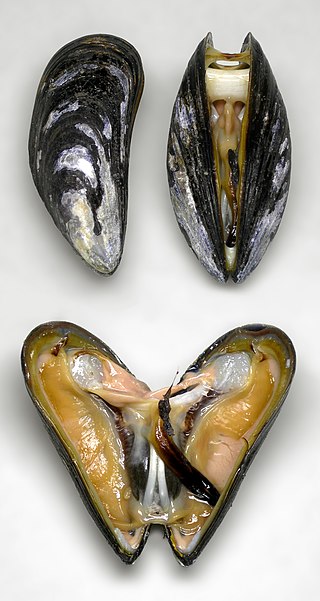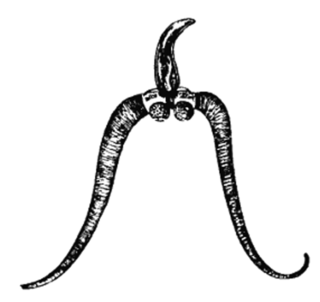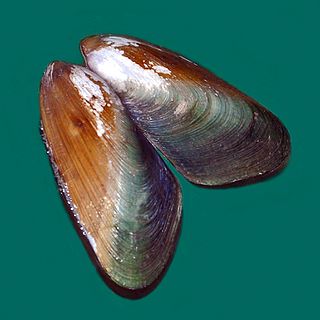
Mussel is the common name used for members of several families of bivalve molluscs, from saltwater and freshwater habitats. These groups have in common a shell whose outline is elongated and asymmetrical compared with other edible clams, which are often more or less rounded or oval.

Bivalvia or bivalves, in previous centuries referred to as the Lamellibranchiata and Pelecypoda, is a class of aquatic molluscs that have laterally compressed soft bodies enclosed by a calcified exoskeleton consisting of a hinged pair of half-shells known as valves. As a group, bivalves have no head and lack some typical molluscan organs such as the radula and the odontophore. Their gills have evolved into ctenidia, specialised organs for feeding and breathing.

A byssus is a bundle of filaments secreted by many species of bivalve mollusc that function to attach the mollusc to a solid surface. Species from several families of clams have a byssus, including pen shells (Pinnidae), true mussels (Mytilidae), and Dreissenidae.

The zebra mussel is a small freshwater mussel, an aquatic bivalve mollusk in the family Dreissenidae. The species originates from the lakes of southern Russia and Ukraine, but has been accidentally introduced to numerous other areas and has become an invasive species in many countries worldwide. Since the 1980s, the species has invaded the Great Lakes, Hudson River, Lake Travis, Finger Lakes, Lake Bonaparte, and Lake Simcoe. The adverse effects of dreissenid mussels on freshwater systems have led to their ranking as one of the world's most invasive aquatic species.

The blue mussel, also known as the common mussel, is a medium-sized edible marine bivalve mollusc in the family Mytilidae, the only extant family in the order Mytilida, known as "true mussels". Blue mussels are subject to commercial use and intensive aquaculture. A species with a large range, empty shells are commonly found on beaches around the world.

The quagga mussel is a species of freshwater mussel, an aquatic bivalve mollusk in the family Dreissenidae. It has an average lifespan of 3 to 5 years.

Mytilopsis sallei, the black-striped mussel, is a small marine bivalve mollusc in the family Dreissenidae, the false mussels.
The Dreissenidae are a family of small freshwater aquatic bivalve molluscs, commonly called mussels although not at all closely related to true mussels. The shells of these bivalves are shaped somewhat like those of true mussels, which they also resemble in attaching themselves to a hard substrate such as stone using a byssus; however, this group is more closely related to the venus clams (Veneridae).

The Unionidae are a family of freshwater mussels, the largest in the order Unionida, the bivalve molluscs sometimes known as river mussels, or simply as unionids.

Unionida is a monophyletic order of freshwater mussels, aquatic bivalve molluscs. The order includes most of the larger freshwater mussels, including the freshwater pearl mussels. The most common families are the Unionidae and the Margaritiferidae. All have in common a larval stage that is temporarily parasitic on fish, nacreous shells, high in organic matter, that may crack upon drying out, and siphons too short to permit the animal to live deeply buried in sediment.

Atrina fragilis, the fan mussel, is a species of large saltwater clam, a marine bivalve mollusc in the family Pinnidae, the pen shells.
Freshwater bivalves are molluscs of the order Bivalvia that inhabit freshwater ecosystems. They are one of the two main groups of freshwater molluscs, along with freshwater snails.

The glochidium is a microscopic larval stage of some freshwater mussels, aquatic bivalve mollusks in the families Unionidae and Margaritiferidae, the river mussels and European freshwater pearl mussels.

Paetulunio fabalis, the rayed bean, is a species of freshwater mussel, an aquatic bivalve mollusk in the family Unionidae, the river mussels. It is the only species in the genus Paetulunio, and was formerly classified in Villosa until a 2018 study.

Mytilopsis leucophaeata is a species of small bivalve mollusc in the false mussel family, Dreissenidae. It is commonly known as Conrad's false mussel or the dark false mussel.

The shinyrayed pocketbook is an endangered species of freshwater mussel in the family Unionidae, the river mussels. This species is endemic to the United States in the states of Georgia, Florida, and Alabama.

Bucephalus polymorphus is a type of flatworm. This species is within the Bucephalidae family of Digenea, which in turn is a subclass of Trematodes within the phylum Platyhelminthes. It is characterized by having a mouth near the middle of its body, along with a sac-like gut. The mouth opening is located in the centre of the ventral surface. This is a specific body type of cecaria known as a gastrostome.

Pinna carnea, commonly called the amber pen shell, is a species of bivalve mollusc in the family Pinnidae.

Limnoperna fortunei, the golden mussel, is a medium-sized freshwater bivalve mollusc of the family Mytilidae. The native range of the species is China, but it has accidentally been introduced to South America and several Asian countries where it has become an invasive species. It is considered to be an ecosystem engineer because it alters the nature of the water and the bottom habitats of lakes and rivers and modifies the associated invertebrate communities. It also has strong effects on the properties of the water column, modifying nutrient proportions and concentrations, increasing water transparency, decreasing phytoplankton and zooplankton densities, on which it feeds, and enhancing the growth of aquatic macrophytes. Because mussels attach to hard substrata, including the components of industrial, water-treatment and power plants, they have become a major biofouling problem in the areas invaded.

Mytella guyanensis is a species of tropical saltwater mussel, marine bivalve molluscs in the family Mytilidae. This species has been referred to colloquially as the “Trinidad Swamp Mussel” —although not formally confirmed as the common name. It was first described in detail by the French naturalist Jean Baptiste Lamarck in 1819.




















